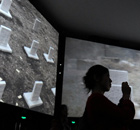Latest News
Cultural, historic treasures rescued from monastery
By Qi Xiao and Hu Yongqi (China Daily)
Updated: 2010-04-26 07:15
 |
Large Medium Small |
YUSHU, Qinghai - Using their bare hands, armed police officers recovered thousands of valuable cultural and historic relics from a heavily damaged Tibetan temple in Yushu.
Established more than 700 years ago, the Thrangu Monastery is the biggest temple of the White Sect of Tibetan Buddhism in Yushu and has a huge collection of Buddhist scriptures.
However, the main hall has cracks on all sides and the other buildings have collapsed.
"Our top priority was to save lives," said Captain Li Yanming, who led about 200 officers from the Chinese Armed Police Force to the temple last Friday.
But they had no luck.
|
| |||
"He was very anxious and told us that his precious belongings were under the rubble," said Second Lieutenant Zhu Lizhang. "Because he didn't speak much Mandarin, we didn't know exactly what he wanted."
The soldiers dug out a cellphone where Choyong Dorje pointed, only to find that it was not "his treasure".
After a couple of hours of careful excavation, they finally saw "his treasure": a sutra text.
"He said the text was bestowed from an elderly Tibetan living Buddha and was of vital importance to him," Li said.
It was the way that Choyong Dorje received the text that struck him most, Zhu added. "Knees a little bent, both hands out and head bowed down: a most pious posture that you could see from a Tibetan monk."
Thus began their three days of unearthing Tibetan treasures.
Because of the delicate nature of the Buddha statues, sutra texts and thangka - a Tibetan silk painting with embroidery usually depicting a Buddhist deity, famous scene or mandala - the soldiers only used their hands.
When the soldiers unearthed a Buddha statue, they used two hands to hold it and never touched the head. They only dug where monks told them to and when monks were present.
"Every item was registered by both the temple and us to avoid confusion," said Colonel Kong Xin. "We should respect the Tibetan religion and its customs, which hold tremendous respect for these relics. In fact, we were all required to wear gloves."
Since the temple was made of mud and wood, they actually could not find a place to begin as the fallen dirt virtually sealed all the cracks. Nails stuck out of the broken beams and the frayed roof in the main hall could have fallen down any minute.
"Our hands were only slightly injured," said Li Yanming and Zhu Lizhang, both showing hands with cuts and bruises. "One of our soldiers was slashed more than a dozen times in each hand and several others couldn't even make a fist when we were done."
More than 600 pairs of gloves were worn out.
In total, 1,635 Buddha statutes, 4,376 sutra texts and 120 pieces of thangka were saved from the rubble, though some were damaged.
Local Tibetan residents around the area showed their appreciation for the soldiers' efforts by offering sugar water and calling them "huo pusa" (living Buddha).
"These relics are invaluable," said Living Buddha Lodroe Nyima Rinpoche. "The soldiers worked very hard under very harsh conditions and they turned in every item uncovered to me before registering it and they showed respect for the relics."
"I can't thank them enough," he said.
China Daily
(China Daily 04/26/2010 page3)








